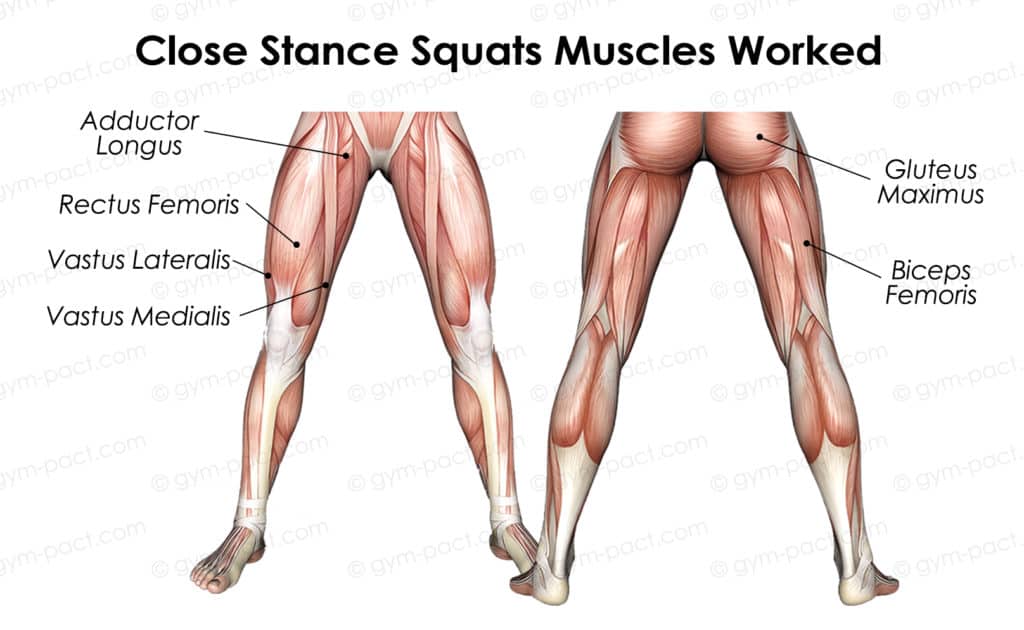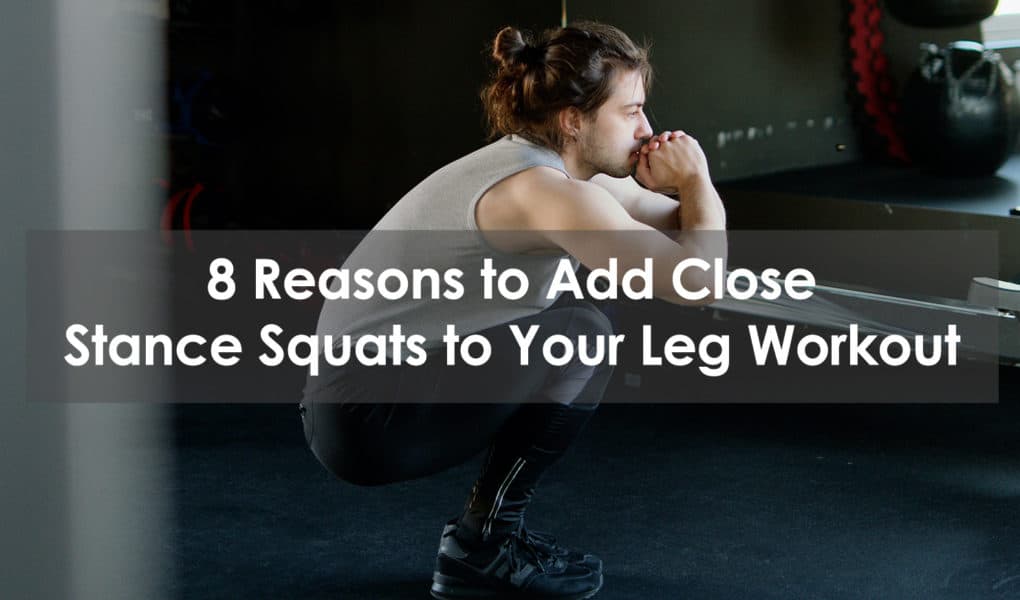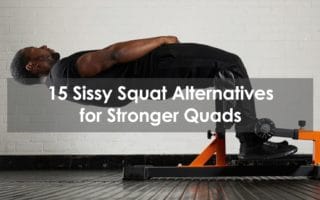While most people who train are used to performing squats as a staple exercise, most beginners start with regular stance widths. But depending on your muscular strength goals in your training routine, a different squat style may be just the thing you’re looking for to take your training to the next level.
Narrow or close stance squats allow for a deep squat, using the primary knee extensors to get the knee position out of maximal flexion. Although they require a lot of ankle mobility to avoid being limited by a partial range of motion, narrow squats also utilize more calf muscle activation than other squats.
This article will explain the many benefits this accessory movement can have in your lower body workout. For bodybuilders, strength athletes, or casual gym-goers, there will be a new tip here for you that you may not have known about narrower stance squats, so enjoy!
Muscles Worked in Close Stance Squats
Narrow squats can target muscle strength and muscle building in all of the biggest muscles in the lower body. They require work from the superficial thigh muscles, including the rectus femoris, vastus lateralis, and vastus medialis anteriorly; the adductor longus medially; the biceps femoris and gluteus maximus posteriorly.

Close stance squats also require the involvement of many other accessory muscles, such as the core muscles, shin muscles, and posterior calf, and many smaller muscles around the knee joint, hip joint, ankle, and spine.
Knowing the many muscles trained by this exercise, let’s look at some of the specific benefits of performing narrow stance squats in particular.
8 Benefits of Close Stance Squats
1. Corrects imbalances
Narrow stance squats make it more difficult for one leg to take over the movement. With a wide squat, for example, you can shift your weight over one leg if that side is stronger, whereas, with narrow squats, this will cause you to lose balance.
In addition to helping correct weaknesses on one side, these squats will also correct imbalances within the leg musculature. Because they focus more on the outer thigh and glutes, close stance squats can improve muscle size and strength, creating a more aesthetic and balanced lower body physique.
2. Hypertrophy
While close stance squats can be done as a heavy strength exercise, they are more typically done with a lighter weight and higher volume. These extra reps and sets are perfect for creating a metabolic overload in the muscles and stimulating growth.
The added range of motion and unique involvement of different leg muscles also makes this move great for adding mass to the calves, tibialis anterior (front of the shin), outer quads, and glutes. If getting big legs is your goal, follow some of the great bodybuilders and start squatting narrow!
3. Accessory exercise
The narrow stance squat isn’t something to do in isolation. If you typically do regular or wider stance squats to improve your maximal squat load, it is unlikely that narrow squats will allow you to lift more weight than your go-to variation.
What they will do, however, is allow you to add strength to other muscles that will help your maximal strength overall. This is why many powerlifters and use narrow squats as an accessory exercise to help their main squat, in the same way, that a narrow bench press will help strengthen the often weak triceps to allow a heavier bench press.
4. Improve knee biomechanics
Narrow squats allow for a much greater range of motion at the knee, achieving near-maximal knee flexion at the bottom of the movement. They also typically use a much straighter foot angle than wide squats, which have the feet turned out to avoid medial displacement of the knee joint, which can lead to knee discomfort and injury.
When analyzing joint function, we must also consider the joints above and below. This means that the narrow squat can improve ankle mobility, as well as hip flexion and control. In turn, these both affect the function of the knee joint. When all working together, these three lower body movers will all benefit from improving technique with the close stance squat.
5. Warm-up exercise
Narrow squats are also a great way to warm up the legs before heavier work. Multiple sets can be done to get blood pumping into the legs, activate nervous system control and balance of the lower body, and warm up core activation and posture before loading up with heavy weight.
An example of how close squats could be done as a lower-body workout warm-up is with a set of bodyweight narrow squats, followed by narrow front squats with a light weight (see video example below), then finally a set of barbell narrow squats with just the bar.
6. Practice control
This type of squat is probably the most difficult, and can’t be done by just anybody straight away. Because we squat from the ground up, ankle flexibility is the first thing that will stop someone from being able to perform a narrow stance. This applies particularly to taller individuals, whose longer limb lengths create more difficulty in squatting deep with a narrow stance.
This exercise is also a great way to practice controlling the hips and knees. With this variation, you really need to sit the hips back while keeping the center of gravity forward to avoid falling backward. The knees will also require focus to stay aligned, without tracking inwards or outwards, which will put unwanted strain through the joint and soft tissues.
7. Good squat for light intensity
In the same way that narrow stance squats can be done as a warm-up exercise, there’s nothing stopping you from doing more sets at a lower intensity! Some of the most grueling leg workouts come from having higher reps at a lower weight, so you can really control the burn.
Alternatively, if you want to hit legs on a day in-between your heavy squat or deadlift workouts, just to get the blood pumping through, you can add close stance squats into your off-day. Focus more on technique and range of motion than punishing your muscles, and save the hard work for your primary leg workouts.
8. Work on weaknesses
Whether it’s a discrepancy between legs, or the inner and outer thigh muscles, many gym-goers have weaker muscles that can lead to injury over the long term. Because many people already train many leg movements with a standard or slightly wider than shoulder-width position, the muscles that bring the knee into alignment laterally can lag behind. Over time, this creates stress and friction through the tendons and ligaments around the joints.
Narrow squats can create more work for the lateral thigh and glutes, strengthening lagging muscle groups to create a balanced, healthier musculoskeletal system.
Now we’ve hopefully convinced you to add this great exercise to your routine, here is how to perform it correctly to get the most out of it while avoiding mistakes or injury.
How to Perform Close Stance Squats with Good Technique
Before starting, it’s important to consider whether you have the necessary level of mobility, or require the aid of squat shoes or other heel lifting aid to perform the movement. In addition, start with a lighter weight as you improve the technique of this movement.
The starting position of a narrow squat is a standing upright posture, with the bar position in a comfortable placement across the shoulders. Take a deep breath then keep your intra-abdominal pressure-tight as the hip shifts backward.
Pay attention to knee tracking as you continue to the lowest portion of the movement, with the hamstrings resting as close to the calves as possible. Keep all the upper and lower body muscles engaged as you press through the heels on your way up. Stand upright, and repeat for the desired number of repetitions.
A heavier load will create more shear stress through the joints, so try to use the perfect form with a lighter load before progressing.
This video is an example explainer video on how to perform a narrow stance squat with a dumbbell, bringing the weight in front of the body for improved balance:
The following video is a great example of the narrow squat as a lower body strength exercise with impressive bar loads!
Conclusion
We hope this article informed you about the benefits of squats in a narrower stance, and we encourage you to give this type of squat a try as part of your exercise routine!
Frequently Asked Questions
What squat stance is best?
While there is no one ‘best’ squat position in all cases, there are better squat variations for different people, based on body type or goals. A tall lifter might improve their squat strength better with a wide stance squat, for example; whereas traditional squats or narrow squats might allow for a larger range of motion if you’re working on squat depth.
How do I find my squat stance?
Start with a regular squat, with feet hip-width apart. Focus on quad activation, hip mobility, and gluteus maximus contraction. From there, try a wider stance, as well as a few sets of narrow stance squats. Make a mental note of how the different variations affect your muscle activation, both on your primary muscles and secondary muscles. Choose the version that works best for your goals.
Are wide squats harder?
While wider stance squats, whether it’s barbell squats or other versions, aren’t necessarily harder than other variations, they will activate the glute muscles and hip muscles more. This makes them the preferred choice for some as a powerlifting squat, as the shorter muscle lengths of the leg muscles, along with less knee flexion, allowing for more weight to be lifted.







